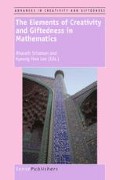Abstract
This study investigates high achieving students’ mathematical reasoning when given an unfamiliar trigonometric equation. The findings indicate that the students’ way of thinking is strongly linked with imitative reasoning and only when they received some form of guidance, were they able to display flexible and creative mathematical reasoning.
Access this chapter
Tax calculation will be finalised at checkout
Purchases are for personal use only
Preview
Unable to display preview. Download preview PDF.
References
Ausubel, D. (1962). A subsumption theory of meaningful verbal learning and retention. The Journal of General Psychology, 66, 213–244.
Bergqvist, E. (2007). Types of reasoning required in university exams in mathematics. Journal of Mathematical Behavior, 26, 348–370.
Clement, J. (2000). Analysis of clinical interviews: Foundation and model viability. In Handbook of research design in mathematics and science education. New Jersey, NJ: Lawrence Erlbaum.
Cox, W. (1994). Strategic learning in a level mathematics? Teaching Mathematics and its Applications, 13, 11–21.
Ericsson, K., & Simon, H. (1993). Protocol analysis: Verbal reports as data. Cambridge: MIT Press.
Franklin, C. S., & Ballan, M. (2001) Reliability and validity in qualitative research. In The handbook of social work research methods. Sage Publications Inc.
Freudenthal, H. (1991). Revisiting mathematics education: China lectures. Dordrecht, Boston: Kluwer Academic Publishers.
Gray, E., & Tall, D. (1991). Duality, ambiguity and fexibility in successful mathematical thinking. Proceedings of PME, 15(2), 72–79.
Halmos, P. (1980). The heart of mathematics. American Mathematical Monthly, 87(7), 519–524.
Hammersley, M. (1990). Reading ethnographic research: A critical guide. London: Longmans.
Harel, G. (2008). What is mathematics? a pedagogical answer to a philosophical question. In R. Gold & R. Simons (Eds.), Current issues in the philosophy of mathematics from the perspective of mathematicians.
Hiebert, J. (2003). What research says about the NCTM standards. In A research companion to principles and standards for school mathematics. Reston, VA: National Council of Teachers of Mathematics
Hiebert, J., & Lefevre, P. (1986). Conceptual and procedural knowledge in mathematics: An introductory analysis. In J. Hiebert (Ed.), Conceptual and procedural knowledge: The case of mathematics (pp. 1–27). Hillsdale, NJ: Lawrence Erlbaum Associates.
Kamii, C., & Dominick, A. (1997). To teach or not to teach algorithms. Journal of Mathematical Behavior, 16, 51–61.
Klette, K., Lie, S., Ødegaard, M., Øystein Anmarkrud, Arnesen, N., Bergem, O. K., et al. (2008). Pisa+: Lærings og undervisningsstrategier i skolen technical report. ILS, UiO.
Lithner, J. (2000). Mathematical reasoning in task solving. Educational Studies in Mathematics, 41(2), 165–190.
Lithner, J. (2003). Students’ mathematical reasoning in university textbook exercises. Educational Studies in Mathematics, 52, 29–55.
Lithner, J. (2005). A framework for analysing qualities of mathematical reasoning: Version 3. In Research reports in mathematics education (p. 3). Department of Mathematics, Umea University.
Lithner, J. (2006). A framework for analysing creative and imitative mathematical reasoning. Umea: Department of Mathematics, Umea University.
Lithner, J. (2008). A research framework for creative and imitative reasoning. Educational Studies in Mathematics, 67, 255–276.
McNeal, B. (1995). Learning not to think in a textbookbased mathematics class. Journal of Mathematical Behavior, 14, 18–32.
Mullis, I., Martin, M., Robitaille, D., & Foy, P. (2009). TIMSS advanced 2008 international report: Findings from IEA’s study of achievement in advanced mathematics and physics in the final year of secondary school. Chestnut Hill, MA: TIMSS & PIRLS International Study Center, Boston College.
NCTM. (2000). Principles and standards for school mathematics. Reston, VA: National Council of Teachers of Mathematics.
Niss, M. (1999). Aspects of the nature and state of research in mathematics education. Educational studies in mathematics, 40, 1–24.
Niss, M., & Jensen, T. H. (2002). Kompetencer og matematiklrring. Ideer og inspiration til udvikling af matematikundervisning i Danmark Utdannelelsesstyrelsens temahefteserie nr 18- 2002. Undervisningsministeriet.
KD. (2006). Kunnskapsløftet. Oslo: Utdanningsdirektoratet/Norwegian directorate for education and training. Retrieved August 30, 2010, from http://www.udir.no/grep
Pesek, D., & Kirshner, D. (2000). Interference of instrumental instruction in subsequent relational learning. Journal for Research in Mathematics Educational Action Research, 31, 524–540.
Polya, G. (1954). Mathematics and plausible reasoning. Princeton, NJ: Princeton University Press.
Ritchie, J., & Lewis, J. (2003). Qualitative research practice. Sage Publications Ltd.
Schoenfeld, A. (1985). Mathematical problem solving. Orlando, FL: Academic Press.
Selden, J., Selden, A., & Mason, A. (1994). Even good calculus students can’t solve nonroutine problems. In J. Kaput & E. Dubinsky (Eds.), Research issues in undergraduate mathematics learning. Washington, DC: Mathematical Association of America.
Sfard, A., & Linchevski, L. (1994). The gains and the pitfalls of reifcation the case of algebra. Educational Studies in Mathematics, 26, 191–228.
Silverman, D. (2006). Interpreting qualitative data. Sage Publications Ltd.
Skemp, R. R. (1976). Relational understanding and instrumental understanding. Mathematics Teaching, 77, 20–26.
Sriraman, B. (2009). The characteristics of mathematical creativity. ZDM, 41(1), 19–34.
Sternberg, R., & Lubart, T. (1999). The concept of creativity: Prospects and paradigms. In Handbook of creativity. Cambridge University Press.
Yackel, E., & Hanna, G. (2003). Reasoning and proof. In J. Kilpatrick, G. Martin, & Schifter, D (Eds.), A research companion to principles and standards for school mathematics. Reston, VA: National Council of Teachers of Mathematics.
Author information
Authors and Affiliations
Editor information
Editors and Affiliations
Rights and permissions
Copyright information
© 2011 Sense Publishers
About this chapter
Cite this chapter
Øystein, H.P. (2011). What Characterises High Achieving Students’ Mathematical Reasoning?. In: Sriraman, B., Lee, K.H. (eds) The Elements of Creativity and Giftedness in Mathematics. Advances in Creativity and Giftedness, vol 1. SensePublishers. https://doi.org/10.1007/978-94-6091-439-3_13
Download citation
DOI: https://doi.org/10.1007/978-94-6091-439-3_13
Publisher Name: SensePublishers
Online ISBN: 978-94-6091-439-3
eBook Packages: Humanities, Social Sciences and LawEducation (R0)


